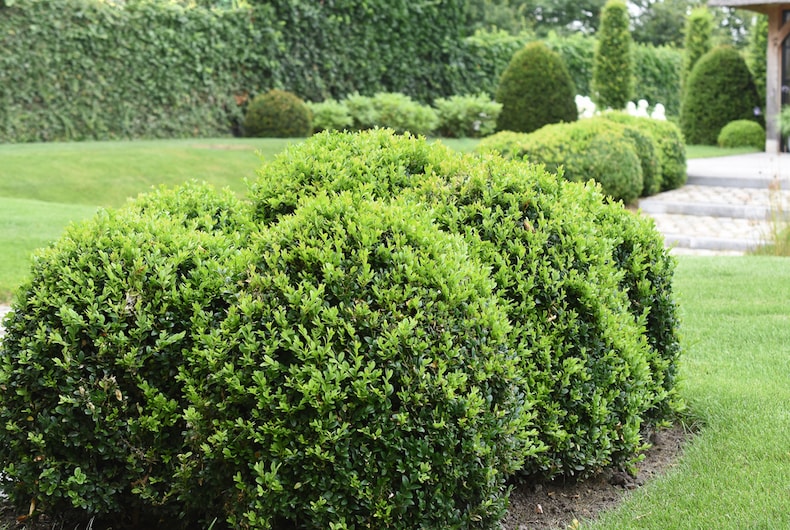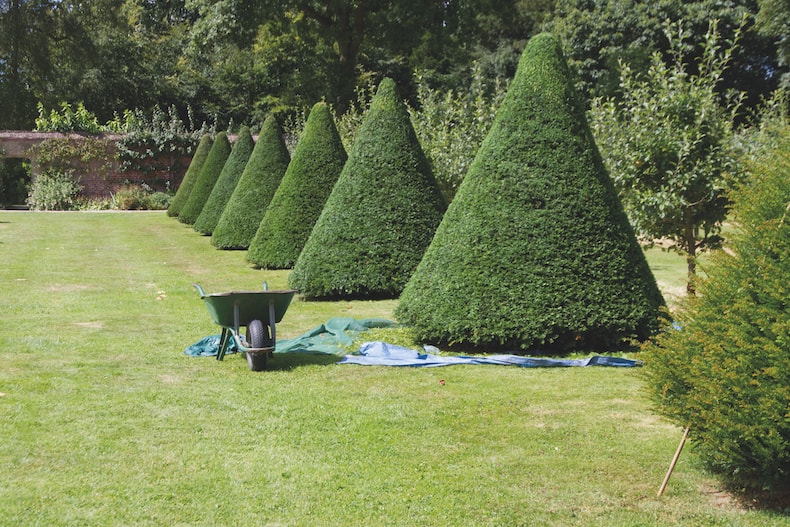
How to prune box and yew
Box and Yew have long been used to add formality to gardens as hedges or topiary.
Either way, they need regular pruning to keep their shape. Use sharp and clean hedge cutters or shears, especially when pruning Box, as damage makes the plants more susceptible to box blight. It’s also advisable to disinfect tools after pruning. Here’s how to prune your Box and Yew like a pro…
How to prune box and yew hedges

Box can be pruned to form tight hedges or glorious shapes
Image: Box Hedging from Thompson & Morgan
If you’re pruning a hedge, always take the time to string a line to ensure a level and straight finish. You should also check for nesting birds before you begin as it’s illegal to disturb them. If your hedge is tall, get yourself a sturdy set of steps so you can tackle the job safely.
Large, formal hedges should be cut with a slight taper towards the top. This allows more light to get to the bottom of the hedge. Lower hedges, such as in a parterre, should have vertical sides. Either way, do keep stepping back and checking as you clip – it’s all too easy to cut off too much.
If you need to rejuvenate an overgrown hedge, both box and yew can be cut back hard in late spring. In the case of yew hedges, this is best done gradually. Cut back one side and allow it to regrow before tackling the other side.
When is the best time to prune Box hedges?

Prune Box twice a year - in May and September
Image: Thompson & Morgan
Prune box (Buxus) in late May or early June after all risk of frost has passed. It can then be tidied up in September to ensure a crisp finish over winter.
Choose a dry but cloudy day to tackle your hedge or trim your topiary. Avoid pruning in hot sunshine as this can lead to leaf scorch, while damp, humid conditions encourage the spread of box blight.
Remove all the clippings immediately to discourage the spread of blight. If you put down some plastic before you start work, it’s easier to whisk them away when you’re done.
When is the best time to prune Yew hedges?
Prune Yew hedges from August to October
Image: English Yew Hedging from Thompson & Morgan
Yew (Taxus baccata) can be kept in shape with an annual trim, best done between August and October.
Yew can grow up to 12 inches in a season. If you want a thick, dense hedge, don’t trim the ‘leader’ until it reaches the height you require. Trimming the side shoots, however, will encourage bushier growth and stimulate the hedge to thicken up as it grows.
How to trim topiary shapes

Regularly trim your topiary to keep your chosen style looking neat
Image: Thompson & Morgan
Topiary shapes such as balls, spirals or more creative freestyle masterpieces are also best achieved with a guide – bamboo canes are ideal for providing a straight vertical line. Use shears to create the shape, and sharp secateurs to finish the finer details. Trim in May, July and September to maintain a tight, neat shape.
Love the idea of having more formal and topiary hedging plants to trim and prune? Check out our great selection of shrubs for manicured boundaries, topiary structures and impressive hedges. Find conifers growing advice & expert gardening tips at our hub page.
See all pruning guides
Individual guides
Flower & Shrubs
- Pruning Buddleja
- Pruning Camellias
- Pruning Clematis
- Pruning Fuchsias
- Pruning Hydrangeas
- Pruning Hypercium - St Johns Wort
- Pruning Lavender
- Pruning Magnolias
- Pruning Passion Flowers
- Pruning Rhododendron
- Pruning Ribes Sanguineum
- Pruning Rosemary
- Pruning Roses
- Pruning Tree Peonies
- Pruning Wisteria
- Pruning Asparagus
- Pruning Blueberries
- Pruning Goji Berries
- Pruning Honeyberries
- Pruning Raspberries
- Pruning Apple trees
- Pruning Catalpa trees
- Pruning Christmas trees
- Pruning Olive trees
- Pruning Patio Fruit trees
- Pruning Pear trees
- Pruning Plum trees
Fruit & Veg
Trees

Written by: Mandy Bradshaw, the Chatty Gardener
Cotswold-based Garden Media Guild member, Mandy Bradshaw, is also known as the Chatty Gardener. Passionate about gardening and writing, her beginnings are in football reporting for her primary school, and Mesembryanthemum planting with her mother. Winner of the 2018 Property Press Awards 'Garden Journalist of the Year', she writes for not only her own blog but also a range of newspapers, magazines and other gardening and non-gardening sites.Banner image: Yolanta/ Shutterstock







